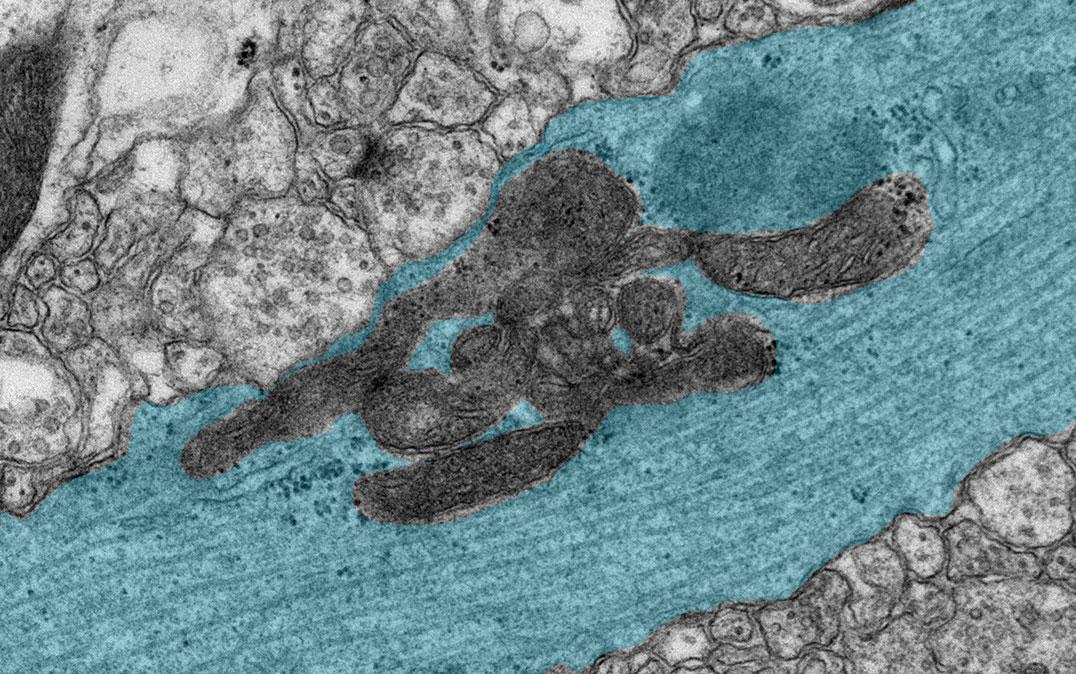Research News
Two Hits to the Mitochondria Causes Severe Anemia
 Micrograph of Mitochondria
Micrograph of Mitochondria
Researchers from The University of Tsukuba find that interfering with mitochondrial respiration and morphological dynamics, separately or in combination, causes anemia in a mouse model
Tsukuba, Japan—Mitochondria may seem like small cogs in the complex machinery of the cell, but even little gears can drive big changes. Now, researchers from Japan have found that impairing mitochondria in two different ways can have a profound effect on blood cell development. This research provides new insights for Pearson syndrome, a rare mitochondrial disease for which few treatment options exist.
In a study published in September in Pharmacological Research, researchers from the University of Tsukuba have revealed that disrupting mitochondrial function and dynamics causes anemia through at least two distinct mechanisms.
Bone marrow harbors blood cell precursors called hematopoietic stem cells (HSCs) that eventually form all types of blood cells. During this differentiation process, the HSCs rely increasingly on mitochondria for energy, and the mitochondria undergo characteristic changes in shape that reflect this process.
"While mitochondrial respiration and morphology are known to be important for maintaining steady-state hematopoiesis," says Professor Kaori Ishikawa, lead author on the study, "the details of the effects of these two processes on hematopoiesis in combination are poorly understood."
To investigate the role of mitochondria in blood cell differentiation, the researchers used two mouse models: one carrying a large-scale mitochondrial DNA deletion (mito-miceΔ), and one in which the gene encoding Drp1, which is involved in mitochondrial division, was knocked out (Drp1 KO). They also bred these two mouse lines together to generate a doubly mutated mouse line that carried both the mitochondrial DNA deletion and the Drp1 knockout. Blood cell numbers and features were then assessed in the blood, spleen, and bone marrow.
"The results were strikingly clear," states Ishikawa. "Both the mito-miceΔ model and the Drp1 KO model exhibited anemia, and mice with both mutations had even more severe anemia, demonstrating the key role that both of these factors play in hematopoiesis."
The mito-miceΔ model showed cytoplasmic vacuoles in marrow precursor cells, while the Drp1 KO model showed increased T cell, granulocyte, and macrophage counts and decreased B cell and bone marrow cell counts. In addition, both mutations were associated with abnormal iron metabolism.
"Taken together, our findings suggest that mitochondrial respiration and morphology play key, yet distinct, roles in hematopoietic differentiation," states Ishikawa.
Given the similarity to the phenotypes seen in patients with Pearson syndrome, a rare mitochondrial disease, the mito-miceΔ model could be useful for studying the mechanisms of this condition. There are few effective treatments for Pearson syndrome, so gaining a better understanding of how this disease works may assist the development of new treatment approaches.
###
This work was supported by JST FOREST Program (JPMJFR204M to K.I.) from the Japan Science and Technology Agency (JST), Grant-in-Aid for Scientific Research on Innovative Areas (21H00225 323 to K.I.) from the Japan Society for the Promotion of Science (JSPS), MyPred (01GM1911A to A.Y.) from the German Federal Ministry of Education and Research (BMBF), Grant-in-Aid for Scientific Research (B) (22H02536 to K.N.) from the Japan Society for the Promotion of Science (JSPS), and AMED-CREST (JP22gm1110006 to N.I. and K.N.) from the Japan Agency for Medical Research and Development (AMED).
Original Paper
The article, "Pearson syndrome-like anemia induced by accumulation of mutant mtDNA and anemia with imbalanced white blood cell lineages induced by Drp1 deletion in a murine model," was published in Pharmacological Research at DOI: 10.1016/j.phrs.2022.106467
Correspondence
Assistant Professor ISHIKAWA Kaori
Faculty of Life and Environmental Sciences, University of Tsukuba
Related Link
Faculty of Life and Environmental Sciences



